Most Common Injuries in Sport Dogs
Since time immemorial, dogs have remained by our side for their amazing physical gifts such as speed, endurance and agility. With the passage of time, man was selecting those that were better accustomed to hunting and the defense of the home, such as show dogs and collectors. Today, what was once just a job, has become leisure, sports activities and jobs of great responsibility. Among the sports activities we could highlight the greyhound races, the sled dogs or the exhibition and agility tracks. Both working dogs and those of sport and leisure require excellent physical and mental training at all times throughout their lives. More than referring to a strict training, we refer to a lifestyle with great wear and tear throughout the body. Specifically, their joints receive blows or trauma constantly and wear out more quickly than the joints of our pets. These traumatisms usually cause joint inflammation that often goes unnoticed. Many of these sports animals do not usually show pain until the injuries worsen, producing more pain, and being complicated to treat them. The most affected joints are usually those of the front extremities: the shoulder, carpal or wrist and the interphalangeal joints.
{%CAPTION%}
Among the most frequent joint pathologies we find muscle contractures, sprains and dislocations.
- Contractures and muscle aches are one of the most common injuries and are usually caused by poor training. Trainers have to follow a series of steps to get dogs used to the new physical demands of their profession. Many trainers perform these exercises daily to work on strength, endurance and speed in a balanced and progressive way. It is advisable to warm up before exercise, stretch before and after and relax the muscles through massage or more specific techniques such as magnetotherapy.
- Sprains are injuries to the ligaments from sudden movement or from exceeding the physiological limits of joint movement. They are usually accompanied by inflammation, hematoma and pain that prevents movement of the affected joint. In this case, the most affected joint is the wrist and interphalangeal. For example, sled and rescue dogs use the front legs to slow the weight of the body on descending slopes and to cling to the terrain on ascending slopes. This effort accompanied by the weight of their colleagues and the owner usually causes very serious sprains that are usually accompanied by wear of the digital pads and loss of the nail.
- Dislocations are described as an abnormal displacement of the articular surfaces. Traumatic dislocations (from sudden blows or forced movements) usually occur from the rupture of a ligament or tendon of the most important muscle. This causes the bones not to fit as they should producing erosion, muscle atrophy and rupture of other ligaments. For example, when jumping from a considerable height, dogs fall on their front or back legs and can cause the tendon of the biceps muscle to rupture. This would cause the shoulder to disengage and the animal could not support or raise the arm.
The best treatment on these occasions is the prevention of injuries. Dominique Grandjean, director of the sport unit at L’Ecole Nationale Veterinaire d’Alfort and Colonel of the Paris Fire Sappers brigade, states that “A search and rescue dog must always be prepared. Like any athlete, he must train and return to training.” Once the injury appears, more than three weeks of rest are necessary, preventing them from doing their job. Many of them would be left with chronic sequelae, such as osteoarthritis, and with a very high probability of repeating the injury if it is not treated correctly. Physical therapists recommend a good daily workout to strengthen the muscles and stretch the tendons and ligaments well. As for rehabilitation, companies such as Ortocanis.com, offer us hip, elbow and carpal supports that in addition to applying a slight pressure to the joint and being able to choose different degrees of immobilization, keep the joint warm and improve performance. These technical aids made especially for dogs, allow a cure of quality injuries and considerably reduce the time of rehabilitation.
Diana Uribelarrea
UCE University of Valencia





Leave a Reply
Want to join the discussion?Feel free to contribute!